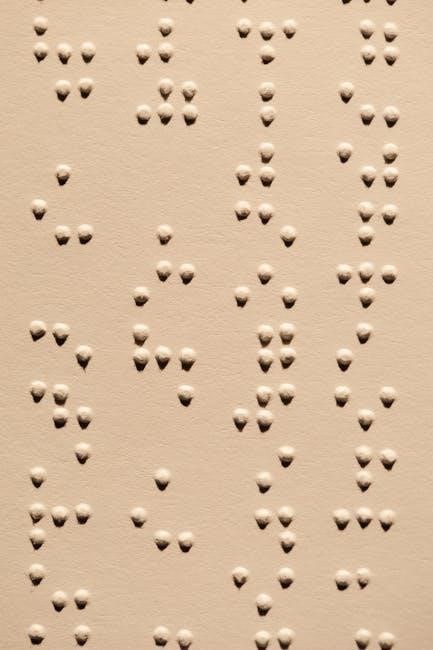Act 2 of Macbeth explores the aftermath of the witches’ prophecies‚ delving into themes of ambition‚ guilt‚ and paranoia. The act sets the stage for tragedy‚ highlighting Macbeth’s moral struggle and Lady Macbeth’s manipulative influence.
Act 2 of Macbeth is a turning point in the play‚ marking the fulfillment of the witches’ prophecies and the escalation of Macbeth’s descent into darkness. The act begins with Macbeth’s iconic dagger soliloquy‚ where he grapples with the moral implications of murder. Lady Macbeth‚ equally consumed by ambition‚ goads him into committing the crime. The murder of King Duncan sets off a chain of events filled with tension and guilt. Lady Macbeth‚ though initially resolute‚ begins to show signs of psychological unraveling. The porter’s scene provides a moment of dark humor‚ contrasting with the gravity of the preceding events. Banquo’s suspicions of Macbeth grow‚ foreshadowing future conflict. By the end of Act 2‚ Macbeth has seized the throne‚ but the consequences of his actions leave both him and Lady Macbeth haunted by their guilt and paranoia.
Key Scenes in Act 2
Act 2 features pivotal moments: Macbeth’s dagger soliloquy‚ Duncan’s murder‚ Lady Macbeth’s manipulative role‚ the porter’s comedic relief‚ and Banquo’s growing suspicions‚ all intensifying the play’s tension and tragic trajectory.
3.1. The Dagger Soliloquy
The dagger soliloquy in Act 2‚ Scene 1‚ is a pivotal moment where Macbeth envisions a floating dagger‚ symbolizing his ambition and guilt. This hallucination reflects his internal conflict and paranoia‚ as he contemplates King Duncan’s murder. The dagger‚ often interpreted as a symbol of his subconscious‚ represents the blurred lines between reality and illusion. Macbeth’s famous lines‚ “Is this a dagger which I see before me?” highlight his psychological turmoil. Shakespeare uses vivid imagery and metaphors to convey Macbeth’s moral struggle‚ as he grapples with the consequences of his actions. The soliloquy reveals his deep-seated fear of guilt and the haunting nature of his ambition. It sets the tone for the tragic events that unfold‚ showcasing Macbeth’s descent into darkness and madness. This scene is a masterful exploration of human psychology‚ emphasizing the destructive power of unchecked ambition and the haunting grip of conscience.
3.2. The Murder of Duncan
The murder of King Duncan in Act 2‚ Scene 2‚ is a pivotal and devastating event in the play. It occurs in Macbeth’s castle‚ where Duncan has arrived as a guest. Lady Macbeth‚ having goaded Macbeth into action‚ waits anxiously for the deed to be done. Macbeth‚ driven by ambition but haunted by doubt‚ commits the murder in Duncan’s chamber. The act is swift but leaves Macbeth deeply disturbed‚ as he is confronted by the horror of his actions. Upon returning‚ Macbeth is overwhelmed by guilt‚ while Lady Macbeth attempts to rationalize the crime. The murder sets off a chain of events‚ including the framing of the servants and the establishment of Macbeth as king. The scene is marked by tension‚ suspense‚ and the psychological unraveling of both Macbeth and Lady Macbeth. It underscores the tragic consequences of unchecked ambition and the moral decay that follows such a heinous act.
3.3. Lady Macbeth’s Role
Lady Macbeth plays a crucial role in Act 2‚ as her manipulative nature and ruthless determination drive the plot forward. She goads Macbeth into committing the murder‚ challenging his masculinity and questioning his courage. Her famous lines‚ “Unsex me here‚ / And fill me from the crown to the toe top-full / Of direst cruelty‚” reveal her willingness to suppress her femininity and embrace darkness. After the murder‚ Lady Macbeth remains calm and composed‚ rationalizing the crime and ensuring the evidence is planted on the servants. However‚ her confidence begins to unravel as she witnesses Macbeth’s guilt-ridden state. Her anxiety and paranoia grow‚ foreshadowing her eventual downfall. Lady Macbeth’s role in Act 2 highlights her complexity as both a manipulator and a victim of her own actions‚ setting the stage for her psychological unraveling in later scenes.
3.4. The Porter’s Scene
The Porter’s scene in Act 2 serves as a moment of comic relief amidst the tension and horror of King Duncan’s murder. The Porter‚ a minor character‚ delivers a lengthy monologue about the effects of alcohol and the moral decay of society. His rambling speech‚ filled with humor and rustic wisdom‚ contrasts sharply with the dark events unfolding elsewhere in the play. The Porter’s dialogue about “hell” being overcrowded with sinners subtly mirrors the moral corruption within Macbeth’s castle. This scene not only provides a breather for the audience but also underscores the themes of guilt and moral accountability. The Porter’s obliviousness to the tragedy highlights the stark divide between the castle’s insiders and outsiders‚ while his musings on vice and sin align with the play’s broader exploration of human nature and consequence.
3.5. Banquo’s Suspicions
Banquo’s suspicions in Act 2 arise from the witches’ prophecies and the eerie events unfolding at Macbeth’s castle. Despite his initial skepticism‚ Banquo is deeply troubled by the witches’ prediction that his descendants will become kings‚ which haunts him even in his sleep. He begins to suspect that Macbeth may have played a role in King Duncan’s murder‚ as the prophecies seem to align with the tragic events. Banquo’s unease grows when he notices Macbeth’s sudden rise to power and the eerie atmosphere of guilt and paranoia surrounding him. He becomes increasingly wary of Macbeth‚ recognizing the danger he poses. Banquo’s suspicions create tension between the two men‚ as he decides to keep a watchful eye on Macbeth‚ fearing that he may target him next to eliminate any threats to his newfound power. This suspicion sets the stage for future conflict and tragedy.

Themes in Act 2
Act 2 explores themes of ambition‚ guilt‚ and paranoia‚ as Macbeth grapples with the consequences of his actions. The supernatural and moral decay further intensify the dramatic tension and psychological turmoil.
4.1. Ambition and Power
Ambition and power are central themes in Act 2‚ as Macbeth and Lady Macbeth’s desire for the throne drives the plot. Macbeth’s soliloquy reveals his internal conflict‚ torn between morality and ambition. Lady Macbeth’s manipulation further fuels his resolve‚ showcasing her own ruthless pursuit of power. The act highlights how unchecked ambition leads to moral decay and violence. Banquo’s suspicions of Macbeth’s rise to power add tension‚ as the prophecy’s fulfillment creates a web of intrigue. The corrupting influence of power is evident in Macbeth’s transformation from a noble warrior to a tyrannical leader. Act 2 underscores Shakespeare’s exploration of how the lust for power can destroy even the most honorable individuals‚ leading to tragic consequences.
4.2. Guilt and Conscience
Guilt and conscience are pervasive themes in Act 2‚ as Macbeth and Lady Macbeth grapple with the moral implications of their actions. Macbeth’s dagger soliloquy illustrates his tormented mind‚ haunted by visions of blood and guilt. After murdering Duncan‚ Macbeth is overcome with remorse‚ unable to shake the feeling of sin. Lady Macbeth‚ though initially dismissive of guilt‚ begins to exhibit signs of psychological distress‚ her conscience unraveling as the act progresses. Their shared secret creates a burden of guilt that strains their relationship and accelerates their downfall. Shakespeare explores how guilt manifests differently in each character: Macbeth’s guilt is immediate and paralyzing‚ while Lady Macbeth’s emerges more subtly‚ ultimately leading to her breakdown. The interplay of guilt and conscience underscores the psychological toll of their ambitions‚ revealing the devastating consequences of unchecked desires.
4.3. Fate vs. Free Will
In Act 2 of Macbeth‚ the tension between fate and free will is a central theme. The witches’ prophecies create a sense of inevitability‚ suggesting that Macbeth’s destiny is predetermined. However‚ Macbeth’s actions demonstrate the exercise of free will‚ as he chooses to commit murder despite his moral reservations. Lady Macbeth further complicates this dynamic by goading Macbeth into fulfilling the prophecy‚ emphasizing the role of personal agency. Banquo’s suspicions highlight the interplay between fate and individual choice‚ as he questions whether the witches’ predictions will unfold naturally or through human intervention. Shakespeare explores how characters navigate between the pull of fate and their own decisions‚ illustrating how ambition and fear can lead individuals to shape their own destinies‚ even if it means tragic consequences. This theme underscores the complexity of human agency in the face of perceived inevitability.
4.4. Appearance vs. Reality
Act 2 of Macbeth heavily explores the theme of appearance vs. reality‚ as characters often hide their true intentions behind a mask of innocence or normalcy. Macbeth‚ for instance‚ pretends to greet King Duncan warmly‚ concealing his murderous plans. Similarly‚ Lady Macbeth feigns courage and confidence‚ yet her inner turmoil and guilt reveal her true state. The witches‚ with their ambiguous prophecies‚ blur the line between reality and illusion‚ further complicating the characters’ perceptions. Banquo’s suspicions of Macbeth highlight the tension between outward loyalty and inward doubt. Even minor characters‚ like the Porter‚ add to this theme by introducing a comedic yet ominous contrast to the dark events unfolding. Shakespeare uses these contrasts to show how easily appearances can deceive‚ creating a sense of moral ambiguity and heightening the tragic tension. This duality underscores the play’s exploration of human nature and the consequences of hiding one’s true self.

Character Analysis
Act 2 delves into the psychological and emotional transformations of Macbeth and Lady Macbeth‚ revealing their guilt‚ paranoia‚ and manipulation. Banquo’s suspicions and minor characters like the Porter add depth to the play’s character dynamics.
5.1. Macbeth’s Transformation
Macbeth’s transformation in Act 2 is profound and tragic. Initially hesitant and conflicted‚ he evolves into a ruthless murderer driven by ambition. The dagger soliloquy reveals his psychological turmoil‚ as he grapples with morality and fear. After killing Duncan‚ Macbeth is consumed by guilt and paranoia‚ unable to reconcile his actions with his conscience. His once-noble character crumbles‚ replaced by a tyrannical figure haunted by visions of blood and betrayal. Lady Macbeth’s manipulation accelerates his descent‚ pushing him to commit atrocities that alienate him from others. By the end of Act 2‚ Macbeth’s transformation is complete‚ leaving him isolated and tormented by the consequences of his choices. This shift underscores Shakespeare’s exploration of ambition’s destructive power and the devastating cost of unchecked desire.
5.2. Lady Macbeth’s Downfall
Lady Macbeth’s downfall in Act 2 is a stark contrast to her earlier resolve. Initially‚ she appears as a strong‚ manipulative figure‚ goading Macbeth into committing the murder. However‚ the gravity of their actions soon overwhelms her. Her infamous “unsex me” speech fades into a haunting reality as guilt consumes her. Sleepwalking and hallucinations reveal her fractured psyche‚ as she relives the crime and Cannot shake the imaginary bloodstains on her hands. Her once-ruthless exterior crumbles‚ exposing a deeply troubled woman tormented by her conscience. Lady Macbeth’s downfall highlights the destructive power of guilt and the psychological toll of sin. Her eventual breakdown underscores the theme of appearances versus reality‚ as her outward strength gives way to inner vulnerability. By the end of Act 2‚ Lady Macbeth’s transformation from a manipulative instigator to a broken‚ guilt-ridden figure sets the stage for her tragic demise.
5.3. Banquo’s Prophecies
Banquo’s prophecies in Act 2 play a pivotal role in shaping the plot and characters’ motivations. The witches’ prediction that Banquo’s descendants will reign as kings seeds both hope and suspicion within him. While he does not actively pursue the throne like Macbeth‚ Banquo’s awareness of the prophecy creates tension. His unease is evident when he accompanies Duncan to Inverness‚ where he is haunted by the witches’ words in his dreams. This internal conflict makes Banquo a tragic figure‚ as he is torn between loyalty to Macbeth and the allure of the prophecy. Macbeth‚ fearing Banquo’s potential threat‚ begins to view him as an obstacle to his own power. Lady Macbeth’s manipulation further escalates Macbeth’s paranoia‚ leading to tragic consequences. Banquo’s suspicions and the prophecy’s influence highlight the themes of ambition and fate‚ setting the stage for future events. His character serves as a moral counterpoint to Macbeth’s descent into tyranny.
5.4. Minor Characters
In Act 2 of Macbeth‚ minor characters play significant roles in advancing the plot and themes. The Porter‚ for instance‚ provides comic relief with his drunken ramblings‚ but his dialogue also underscores the chaos and moral decay following Duncan’s murder. Lennox‚ a Scottish nobleman‚ appears briefly to discuss the aftermath of the king’s death‚ highlighting the spreading suspicion and political unrest. Additionally‚ the Old Man who enters with Banquo serves as a symbolic figure‚ emphasizing the disruption of natural order and the moral decay that pervades Scotland. These characters‚ though not central to the narrative‚ enrich the play’s texture by offering diverse perspectives and reinforcing the themes of guilt‚ ambition‚ and the breakdown of social stability. Their presence adds depth to the tragic events unfolding in Act 2‚ illustrating how the consequences of Macbeth’s actions reverberate beyond the main characters. Their roles‚ though limited‚ are crucial in shaping the play’s dramatic tension and thematic complexity.

Symbolism in Act 2
Act 2 is rich in symbolism‚ with the dagger representing Macbeth’s guilt and the supernatural. Blood signifies both murder and the haunting consequences of sin‚ while darkness embodies moral corruption and chaos.
6.1. The Dagger
The dagger in Act 2 symbolizes Macbeth’s psychological turmoil and the blurred lines between reality and illusion. It first appears as a hallucination‚ representing his guilt-ridden conscience and the prophecy driving him to murder. The dagger‚ often described as floating before him‚ signifies the inescapable nature of his dark ambition. Its presence highlights the internal conflict Macbeth faces‚ as he struggles with the moral implications of his actions. The dagger also serves as a visual reminder of the violence and bloodshed that will define his reign. Through this symbol‚ Shakespeare illustrates how Macbeth’s ambition consumes him‚ leading him down a path of destruction. The dagger’s recurring imagery reinforces the themes of guilt‚ paranoia‚ and the supernatural‚ making it a pivotal element in the play’s exploration of human morality and the consequences of sin.
6.2. Blood as a Symbol
Blood in Act 2 of Macbeth is a powerful symbol of guilt‚ violence‚ and the irreversible consequences of sin. After Duncan’s murder‚ blood is everywhere—on Macbeth’s hands‚ the dagger‚ and the castle floors. This imagery reinforces the horror of the act and the moral corruption of the characters. Lady Macbeth‚ too‚ is haunted by the blood‚ as seen in her frantic attempts to wash it from her hands‚ symbolizing her inability to cleanse her conscience. The blood also represents the breakdown of order and the chaos that follows the murder. Shakespeare uses blood to evoke a sense of dread and to highlight the psychological turmoil of Macbeth and Lady Macbeth. The repeated references to blood create a vivid reminder of their crimes‚ making it impossible for them—or the audience—to escape the reality of their actions. This symbolism underscores the themes of guilt‚ violence‚ and the destructive nature of ambition.
6.3. Darkness and Night
Darkness and night in Act 2 of Macbeth serve as a backdrop for the unfolding tragedy‚ creating an atmosphere of secrecy and moral ambiguity. The opening scenes take place at night‚ setting a tone of suspense and foreboding. Nighttime becomes a metaphor for the characters’ inner darkness‚ as Macbeth and Lady Macbeth commit their crimes under the cover of darkness. The absence of light symbolizes the absence of moral clarity and the descent into evil. Shakespeare uses darkness to heighten tension and to emphasize the illicit nature of the characters’ actions. The night also serves as a time when inhibitions are lowered‚ allowing the characters to act on their darker impulses. Furthermore‚ the darkness mirrors the chaos and disorder that follow Duncan’s murder. By associating night with sin and destruction‚ Shakespeare reinforces the idea that darkness‚ both literal and metaphorical‚ is a catalyst for the play’s tragic events. This recurring imagery underscores the themes of moral decay and the consequences of sin.

Historical Context
Shakespeare’s Macbeth draws inspiration from Scottish history‚ particularly the reign of King Macbeth‚ who ruled Scotland in the 11th century. The play blends historical facts with mythical elements from Holinshed’s Chronicles.
7.1. Setting and Shakespeare’s Sources
The setting of Act 2 in Macbeth primarily takes place within Macbeth’s castle at Inverness‚ Scotland‚ creating a dark and tense atmosphere. Shakespeare drew inspiration from historical accounts‚ particularly Holinshed’s Chronicles‚ which provided details about King Macbeth of Scotland. The play adapts these historical narratives but embellishes them with supernatural elements‚ such as the witches‚ to heighten dramatic tension. The witches‚ with their beards and ambiguous appearance‚ reflect folklore influences‚ adding depth to the story. The castle setting serves as a backdrop for the moral decay and psychological turmoil of the characters. Shakespeare’s use of these sources blends history with mythology‚ creating a unique and captivating narrative. The setting and sources collectively establish the play’s themes of ambition‚ guilt‚ and the supernatural‚ shaping the tragic events of Act 2.

Study Guide and Resources
Enhance your understanding of Act 2 with study guides‚ video series‚ and quizzes. Resources include summaries‚ character analyses‚ and flashcards to deepen your knowledge of Macbeth’s tragic unfolding.
8.1. Discussion and Essay Topics
Act 2 of Macbeth offers rich material for exploration. Discuss the psychological impact of the dagger soliloquy on Macbeth’s decision-making. Analyze Lady Macbeth’s manipulation and its consequences. Examine the symbolism of blood and darkness. Explore how Banquo’s suspicions foreshadow future events. Consider the moral decay of Macbeth and Lady Macbeth. How does the Porter’s scene provide comic relief amidst tension? What role does guilt play in shaping the characters’ actions? Evaluate the theme of appearance vs. reality in Macbeth’s rise to power. Write about the significance of Macbeth’s transformation from a noble warrior to a tyrant. How does Shakespeare use dialogue to reveal character motivations? Compare and contrast Macbeth’s and Lady Macbeth’s reactions to the murder; Discuss the dramatic irony in Act 2 and its impact on the audience. These topics provide a deeper understanding of the play’s complexities and themes.
8.2. Further Reading
For a deeper understanding of Act 2‚ explore summaries of key scenes‚ such as the dagger soliloquy and the murder of Duncan. Watch video series that provide full readings and analyses of Shakespeare’s text. Utilize study guides and quizzes to test your knowledge of characters‚ themes‚ and plot developments. Read critical essays on Lady Macbeth’s manipulation and Banquo’s growing suspicions. Examine historical contexts and Shakespeare’s sources for inspiration. Discover how the symbolism of blood and darkness reinforces the play’s themes. Explore character analyses‚ such as Macbeth’s transformation from noble warrior to tyrant. Study flashcards to memorize important quotes and terms. Engage with discussion forums to share insights on guilt‚ ambition‚ and fate. These resources will enhance your comprehension of Act 2 and prepare you for further academic exploration.
Act 2 of Macbeth marks a turning point‚ as the characters’ actions lead to irreversible consequences. Macbeth’s descent into darkness‚ Lady Macbeth’s unraveling‚ and Banquo’s suspicions create a tense atmosphere. The dagger soliloquy and Duncan’s murder highlight the moral decay‚ while the porter’s scene provides comic relief. Themes of guilt‚ ambition‚ and fate are central‚ as the characters grapple with their choices. The act’s use of symbolism‚ such as blood and darkness‚ underscores the tragedy unfolding. By the end‚ the characters’ lives are forever altered‚ setting the stage for further turmoil. Act 2 serves as a reminder of the devastating effects of unchecked ambition and the blurred lines between appearance and reality.
